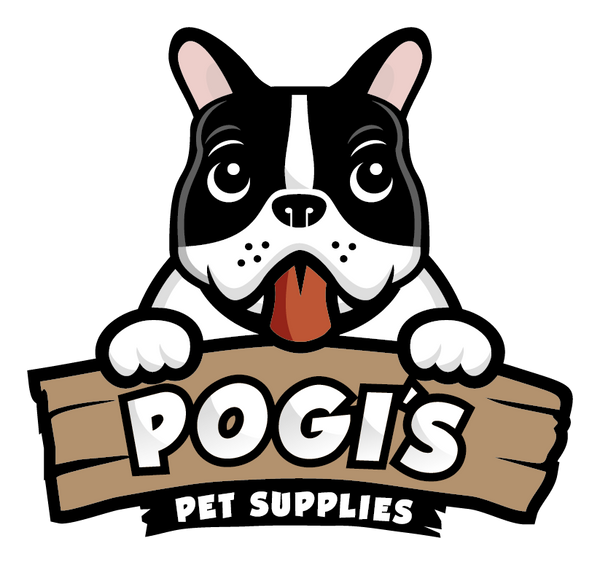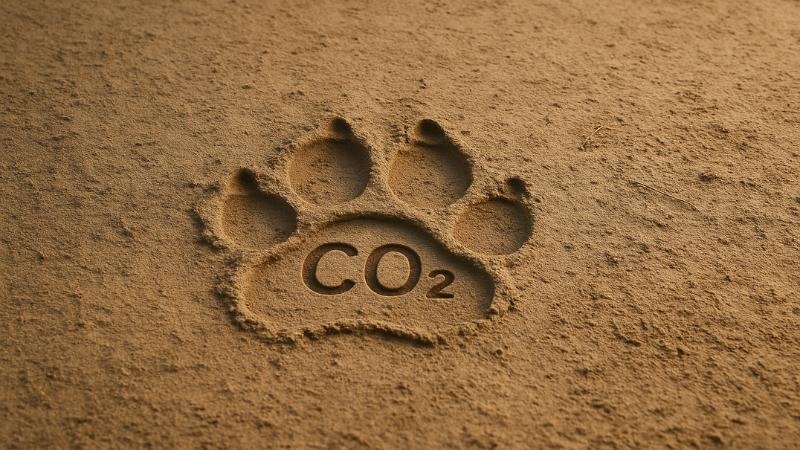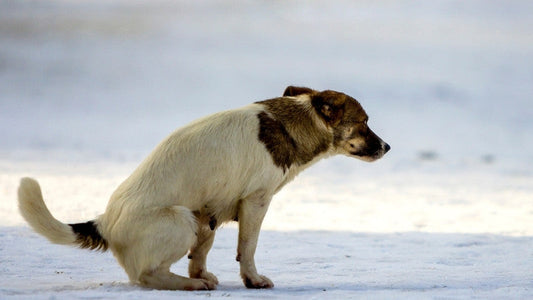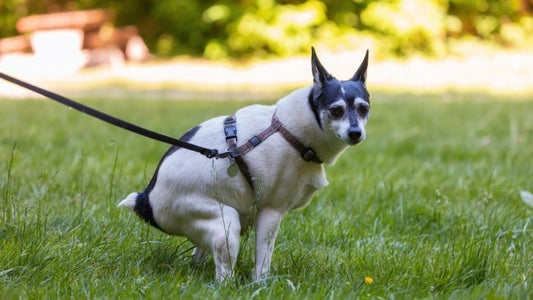Ever wondered if your dog’s dinner is worse for the planet than your daily commute? Turns out, the carbon footprint of a dog—from what they eat to what they leave behind—is roughly equivalent to the emissions of driving a car for thousands of miles. One study conducted by UCLA found that a medium-sized dog contributes as much as 770 kg of CO₂e per year, about the same as driving 9,000 miles in an average family car.
Why? It all comes down to pet food, pet waste, plastic bags, and even pet food packaging, which together make up a surprisingly significant environmental impact. And let’s not forget: your furry friend’s diet likely includes animal byproducts or meat that feeds into global meat consumption and greenhouse gas emissions.
So, is your pup secretly polluting? Not quite—but their pawprint matters. In this guide, you’ll find out how and what you can do about it. Keep reading.
What Adds to a Dog’s Carbon Footprint?
Pet food

Let’s start with the biggest contributor to your dog’s carbon footprint: food. Specifically, meat-based dog's diet has one of the highest environmental tolls.
The pet food industry relies heavily on animal agriculture, which uses vast amounts of agricultural land, water, and fossil fuels, and produces large quantities of carbon dioxide. According to a study on food production and emissions, the global food production system is responsible for 26% of greenhouse gas emissions, and meat consumption alone makes up around 60% of that.
Here’s where it gets more surprising: in the US, pet dogs and cats are responsible for 25–30% of the environmental impact of meat consumption, thanks to their protein-rich diets made largely from animal byproducts and meat scraps, according to PLOS One. Whether it’s kibble made from beef or wet food with chicken chunks, these meals come at a steep climate impact.
To put things into perspective, if the US pet population—roughly 163 million dogs and cats—formed its own country, it'd rank fifth in the world for global meat consumption, as noted in a UCLA study on environmental impact.
And while dog owners might see “chicken dinner” or “beef stew” as just a tasty treat for their pup, each bowl comes with a price. The hidden carbon emissions in pet food make up a significant carbon footprint, especially when multiplied across millions of bowls per day.
So the next time you scoop out your dog’s dinner, you’re not just feeding your pup—you’re participating in a global food chain with a very real environmental footprint.
Pet Waste and Cleanup Products
You might think picking up after your dog is a simple act of responsibility, but it’s also an overlooked contributor to your pet’s carbon footprint. Pet waste, when left on the ground or tossed into landfills in plastic bags, can release methane, a greenhouse gas even more potent than carbon dioxide. And the problem doesn’t end there.
The cleanup itself adds to the environmental footprint. Most people still use plastic bags to scoop poop, many of which are made from fossil fuels and end up sitting in landfills for decades. The production, transportation, and disposal of these bags all contribute to carbon emissions, adding up over time, especially when multiplied by millions of daily walks.
Then there’s the issue of aquatic life. When dog waste isn’t properly disposed of, it can get washed into nearby waterways, introducing pathogens and excess nutrients. This not only pollutes streams and rivers but can also cause harmful algal blooms, which choke out oxygen and devastate local ecosystems.
So while that quick sidewalk scoop might seem harmless, it has a significant environmental impact—from the bag you use to where the waste ends up. Choosing eco-friendly alternatives, like compostable poop bags, can help reduce your pet’s impact without skipping cleanup duty.
Pet Accessories

It’s easy to overlook your dog’s favorite squeaky toy or that stylish new collar—but these everyday items can quietly add to your pet’s carbon footprint.
Most pet accessories—from chew toys to leashes—are made using synthetic materials like plastic and nylon, both of which are derived from fossil fuels. These materials aren’t biodegradable, and their production requires high energy input, contributing to greenhouse gas emissions and long-term environmental damage.
Even seemingly harmless details, like the color of your dog’s collar, come at a cost. The dyeing processes used in manufacturing can consume significant amounts of water and release chemical runoff that pollutes nearby waterways, impacting aquatic life and the environment.
And since most pet products aren't designed to last forever, broken toys or worn-out gear often end up in landfills, further increasing the pet’s impact on the planet.
For dog owners looking to reduce their pet’s carbon footprint, switching to sustainable pet gear made from recycled or plant-based materials can make a real difference—without compromising on style or safety.
Travel and Energy
After food, waste, and accessories, there’s one more piece of the puzzle that adds to your pet's carbon footprint—how you live with and travel alongside your dog.
Think about all those quick car rides to the vet, the dog park, or even a pet-friendly vacation spot. Every trip adds up. While your dog may not be behind the wheel, their routine often involves carbon emissions tied to transportation and energy use.
Even at home, there's energy involved in maintaining their comfort—extra heating in colder months, running washers for muddy towels, or keeping lights on longer for late-night walks. Over time, these seemingly minor habits contribute to a higher carbon footprint, especially for households with bigger dogs or multiple pets.
While we don’t often associate pets with climate change, the choices we make around their lifestyle—from how we travel to the energy we consume—can quietly impact the environment. It's not about cutting out those joys of pet ownership, but recognizing that every convenience, even the coziest blanket or the shortest car trip, comes with a footprint that’s larger than we think—sometimes comparable to that of an average family car over a year.
Finding small ways to reduce these extras—like combining errands, walking instead of driving, or using energy-efficient appliances—helps make your dog’s lifestyle just a bit more eco-conscious.
7 Ways to Reduce Your Dog’s Carbon Pawprint
1. Switch to Compostable Waste Bags

Poop happens—but how you deal with it matters more than you’d think. Those everyday plastic bags? They’re made from fossil fuels, take centuries to break down, and quietly add to your dog’s carbon footprint with every toss.
Swapping to compostable waste bags is one of the easiest ways to reduce your pet’s impact on the planet. It helps cut down greenhouse gas emissions and keeps pet waste from leaking harmful bacteria and nutrients into waterways—something that can damage aquatic life and throw off delicate ecosystems.
If you’re looking for a simple upgrade, Pogi’s Plant-Based Compostable Poop Bags are a game-changer. They’re made with bio-based materials, strong enough for everyday walks, and way better for the environment than standard bags.
A small switch? Yes. But with millions of dogs and cats doing their business every day, it’s the kind of shift that adds up—fast.
2. Choose Sustainable Dog Food Brands
What’s in your dog’s bowl could be doing more harm to the planet than you realize. With meat consumption driving a large portion of global greenhouse gas emissions, it’s no surprise that your dog’s dinner plays a starring role in their overall carbon footprint.
Switching to sustainable pet food brands, those that use plant-based or ethically sourced proteins, can drastically shrink the environmental footprint tied to your dog’s diet. Some newer brands even explore insect-based food as a low-impact protein source that’s easier on agricultural land use and produces fewer emissions than traditional livestock.
And here’s a stat worth chewing on: Overfeeding isn’t just a health concern—it also leads to wasted food production and unnecessary carbon emissions. In fact, 59% of dogs in the U.S. were reported as overweight or obese in 2022, according to the Association for Pet Obesity Prevention.
So when you’re shopping for kibble, look beyond just the flavor and price tag. Choosing brands that care about environmental sustainability—and feeding the right amount—can go a long way in reducing your pet’s carbon pawprint, one meal at a time.
3. Cut Down on Excessive Pet Product Purchases

It’s tempting to fill your home with every cute toy or cozy bed that catches your eye, but those constant purchases quietly add to your dog’s carbon footprint. Many of these items are made from plastic or synthetic fabrics, which aren’t biodegradable and often end up in landfills after just a few months of use.
Choosing durable, natural-material toys instead of quick-fix replacements is a great place to start. When it comes to collars, bowls, and leashes, look for options made from recycled plastic or repurposed materials.
If you’re buying blankets, clothing, or beds, consider fabrics like bamboo, which require fewer resources to produce and leave behind a smaller environmental footprint.
You can also support small businesses that prioritize environmental sustainability and use eco-certified materials. These conscious choices not only reduce waste but also help shift the pet product industry toward more responsible production.
Being selective with what you buy doesn’t take away from your dog’s comfort—it simply ensures your choices reflect your care for both your pet and the planet.
4. Groom Responsibly With Low-Waste Products

Bath time might leave your dog smelling fresh, but the products you use—and how often you use them—can quietly build up their environmental footprint.
Traditional grooming routines often rely on chemical-heavy cleaners, plastic-packaged shampoos, and frequent water use, all of which contribute to carbon emissions and unnecessary waste.
A more sustainable approach starts with low-waste, plant-based grooming products that keep your dog clean without the environmental side effects. Instead of reaching for harsh sprays or detergent-filled wipes, look for formulas made with natural ingredients and minimal packaging.
If your dog just needs a quick refresh, skip the tub entirely. Pogi’s Grooming Wipes are a convenient, low-water solution that lets you clean paws, fur, and even mess-prone areas—no rinsing required. They’re perfect for everyday touch-ups and especially useful after walks or muddy adventures.
You can also try simple at-home tricks in moderation, like using a light dusting of baking soda to absorb excess oils and odors. Just be careful—not all DIY remedies are suitable for frequent use, especially if your pup has sensitive skin or a curious habit of licking everything.
5. Walk More, Drive Less
Not every adventure needs four wheels. While driving your dog to the park might seem like a small convenience, those short car rides can quietly build up a hefty amount of carbon emissions over time, especially when they become part of your daily routine.
Choosing to walk instead, when possible, cuts your pet’s carbon footprint and brings extra benefits for both of you. A brisk neighborhood stroll eliminates the need for fuel, reduces greenhouse gas emissions, and gives your dog the mental and physical stimulation they crave. For dog owners trying to live more sustainably, it’s one of the easiest changes to make.
Plus, ditching the drive helps avoid extra wear and tear on your vehicle, which also contributes to long-term environmental impact through fossil fuel use and maintenance waste.
So the next time your dog’s tail starts wagging for an outing, grab the leash and skip the keys. Your heart, your pup, and the climate will thank you.
6. Recycle or Donate Unused Items
Before you toss that barely-used harness or the chew toy your pup snubbed, take a second look—someone else might need it more than the trash does.
Every unused pet item sent to the landfill adds to the environmental footprint of pet ownership, especially when it's made of plastic, synthetic fabric, or non-recyclable materials.
Instead of throwing things out, donate gently used pet supplies to a local shelter or rescue. It's a simple way to cut back on waste while giving another dog or cat a better shot at comfort. Shelters often welcome bowls, leashes, bedding, and even unopened food. It’s a feel-good move that reduces carbon emissions tied to new product production and helps animals in need.
You can also get creative at home—turn old towels into makeshift dog beds, or repurpose a worn-out hoodie into a cozy blanket. Little actions like these help reduce demand for new materials and keep usable items in circulation longer.
Reducing your pet’s impact doesn’t always mean buying new or cutting back—it can start with rethinking how you handle the things you no longer use.
7. Eco-Friendly Travel Kits for Pets
Road trips with your dog are full of tail wags, window sniffs, and occasional muddy paws—but they can also be full of waste if you’re not careful. From fast-food napkins to single-use plastic bowls, it’s easy to fall into the convenience trap while on the go.
That’s where an eco-friendly travel kit comes in. Pack reusable containers, collapsible bowls, and compostable wipes so you're always ready for snack time or surprise messes—without the landfill guilt. Prepping ahead not only keeps your dog comfortable but also helps reduce carbon emissions linked to the production and disposal of single-use items.
For quick cleanups on hikes or rest stops, toss in a pack of Pogi’s Grooming Wipes. They’re gentle on your pup, travel-sized for convenience, and a smarter alternative to chemical wipes that harm the environment.
A few sustainable swaps in your travel bag can make a big difference for your dog and the planet you’re both exploring.
The Role of Pet Parents in Sustainability
Your dog doesn’t know what a landfill is—but you do.
As a pet parent, you have the power to make choices that reduce your pet’s impact on the environment. While your pup may not think twice about chewing up a toy or leaving a mess behind, the responsibility of what goes into their bowl, their toy bin, and the trash bag falls entirely on you.
That’s not a burden—it’s an opportunity.
Small changes like using compostable poop bags, choosing sustainable pet food, or skipping that extra plastic-wrapped toy might feel minor in isolation. But when multiplied across the millions of pet owners in the U.S., those changes carry real weight, enough to cut back on greenhouse gas emissions, limit plastic waste, and support a more sustainable future for both people and pets.
And here’s where you can make an even bigger difference: by leading through example. Whether it’s chatting with fellow dog walkers about eco-friendly gear or organizing a cleanup at your local dog park, your everyday actions can spark awareness and inspire change in your community.
You know your dog’s habits. Now let the world see yours.
Leave Smaller Pawprints, One Choice at a Time
Your dog’s tail wags, belly rubs, and muddy paw prints are all part of the joy of pet ownership—but so is the responsibility. As you've seen, a dog's carbon footprint stems from everyday things: what they eat, how we clean up after them, and the stuff we buy to keep them happy.
The good news? You don’t have to sacrifice comfort or convenience to live more sustainably. Simple changes—like switching to compostable poop bags, using plant-based grooming wipes, or choosing sustainable pet food—can drastically reduce your pet’s environmental impact without disrupting your routine.
Ready to start? Pogi’s makes eco-friendly living easy with thoughtfully designed, plant-based essentials that care for your dog and the planet. Whether you’re on a walk, cleaning up messes, or stocking up on supplies, you’ll have greener choices right at your fingertips.
Because a cleaner planet starts with cleaner habits—even the four-legged ones.





